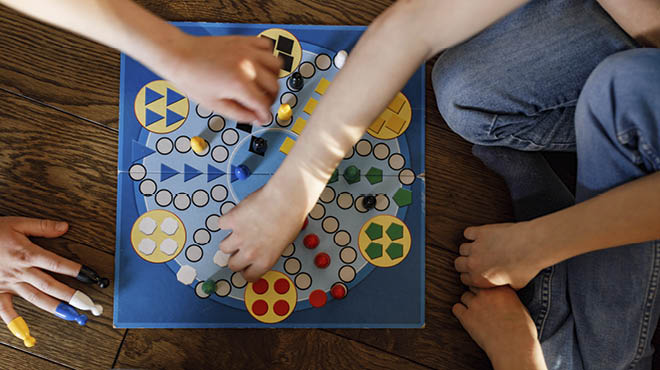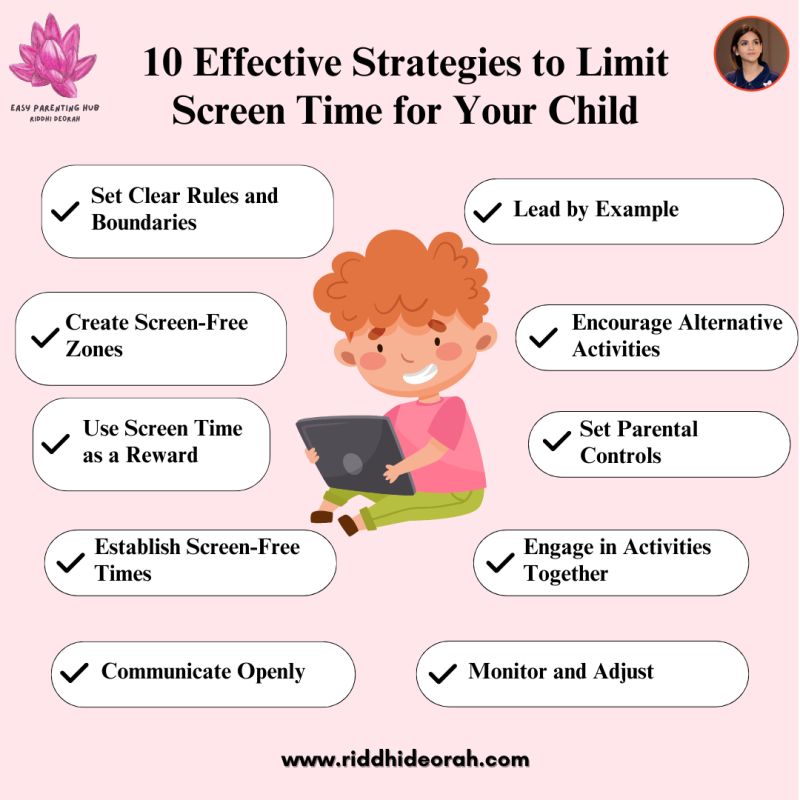Limit screen time for kids by setting daily or weekly limits and curfews, creating tech-free zones or times, and encouraging unplugged, unstructured playtime. This helps promote a healthy balance between screen time and other activities, such as physical play and reading.
It is important to consider the overall health and wellness of the child, including their sleep and exercise habits, when determining the appropriate amount of screen time. By implementing these strategies, parents can help reduce the negative effects of excessive screen time on child development and promote a more balanced lifestyle for their children.

Credit: www.linkedin.com
Table of Contents
ToggleUnderstanding Screen Time
Definition And Types Of Screen Time
Screen time refers to the amount of time spent engaging with digital devices.
Types Of Screen Time:
- Passive Screen Time: Watching television or videos without interaction.
- Interactive Screen Time: Playing games or using educational apps.
- Social Screen Time: Communicating with others via social media platforms.
Impact Of Excessive Screen Time
Excessive screen time can have a detrimental impact on a child’s development and health. It is important to understand the various effects that prolonged exposure to digital devices can have on children.
Effects On Child Development
Cognitive Development: Excessive screen time can hinder a child’s cognitive development, affecting their ability to concentrate, solve problems, and think critically.
Social Skills: Prolonged use of digital devices can impede the development of essential social skills, such as communication, empathy, and conflict resolution.
Health Concerns
Physical Health: Excessive screen time is associated with a sedentary lifestyle, leading to issues such as obesity, poor posture, and physical inactivity.
Mental Health: Prolonged exposure to screens can contribute to mental health issues such as anxiety, depression, and sleep disturbances.
Eye Strain: Continuous screen time can cause eye strain, fatigue, and other vision-related problems in children.
It is imperative for parents to recognize the negative impact of excessive screen time on their children’s overall well-being and take proactive measures to limit their screen usage.
Effective Strategies
Limiting screen time for kids is crucial to their overall well-being and healthy development. With the increasing prevalence of screens in our daily lives, it is imperative for parents to implement effective strategies that promote a balanced lifestyle. In this article, we will explore three key strategies to limit screen time for kids: setting screen time limits, creating tech-free zones, and encouraging physical activities.
Setting Screen Time Limits
Setting clear and reasonable screen time limits is essential to ensure that kids have a healthy balance between screen activities and other important aspects of their lives. Here are some practical tips:
- Define specific time windows for screen usage, such as limiting it to certain hours of the day.
- Establish daily or weekly limits for the total amount of screen time allowed.
- Use parental control features and apps to enforce limits and track screen time usage.
- Communicate and explain the importance of time restrictions to your children, ensuring they understand the rationale behind it.
Creating Tech-free Zones
Designating tech-free zones in your home can help create a healthier environment where kids can engage in different activities without the distraction of screens. Consider the following:
- Designate specific areas, such as the dinner table or bedrooms, as no-screen zones.
- Encourage alternative activities in these tech-free zones, such as board games, reading, or arts and crafts.
- Lead by example and limit your own screen time in these designated areas to set a positive example for your children.
Encouraging Physical Activities
Promoting physical activities is an effective way to reduce screen time and improve children’s overall health. Here are some ideas to encourage kids to be more active:
- Plan regular outdoor activities, such as bike rides, nature walks, or sports, that provide opportunities for physical exercise.
- Enroll your children in sports or other physical classes to cultivate their interest in active hobbies.
- Limit sedentary behaviors by scheduling regular breaks for movement or stretching during prolonged screen time sessions.
- Be actively involved in your child’s physical activities, playing together as a family to create memorable moments and bond.
By implementing these effective strategies, you can ensure that your children have a well-balanced use of screens while also engaging in other enriching activities that contribute to their overall well-being and healthy development.
Age-based Recommendations
Age-Based Recommendations:
Recommended Screen Time By Age
When it comes to screen time for kids…
Screen Time Guidelines For Different Age Groups
Here are the age-based recommendations…
Managing Screen Time
Limiting screen time for kids is crucial for their wellbeing. Encourage outdoor play and establish tech-free zones to minimize screen exposure. Set specific time limits and avoid screen time before bedtime to balance their activities effectively.
Managing Screen Time
In today’s digital era, managing screen time for kids has become a crucial aspect of parenting. Excessive use of screens can negatively impact a child’s physical and mental health, social skills, and overall well-being. As parents, it is essential to establish healthy screen time habits and strike the right balance between technology and other activities. By implementing effective strategies and utilizing the right tools and apps, you can limit screen time and ensure your child’s healthy development.
Tools And Apps To Limit Screen Time
To support your efforts in managing screen time, there are several helpful tools and apps available. These tools empower parents to set boundaries, control usage, and promote healthy screen habits. Here are some popular options that you can consider implementing:
1. Screen Time – This app allows you to set daily time limits, schedule breaks, and remotely control your child’s device usage. It also provides activity reports, enabling you to monitor their digital habits effectively.
2. Parental Control Software – There are various software options available, such as Qustodio and Net Nanny, which offer comprehensive parental control features. These tools enable you to restrict access to certain apps or websites, set time limits, and even monitor your child’s online activity.
3. Built-in Device Features – Many devices come with built-in features that allow you to limit screen time. For example, Apple’s Screen Time feature on iPhones and iPads provides detailed usage reports and allows you to set app-specific limits or downtime periods.
Utilizing these tools can significantly aid in managing screen time and promoting a healthy balance between technology and other activities.
Incorporating Educational Content
While limiting screen time is important, it is equally vital to focus on the quality of the content that your child engages with. Instead of completely eliminating screen time, consider incorporating educational and enriching content into their digital experiences. This approach allows your child to learn and grow while utilizing screens responsibly. Here are some ways you can incorporate educational content:
1. Educational Apps and Games – There are numerous educational apps and games available that promote learning and skill development. Look for apps that align with your child’s interests and provide valuable educational content.
2. Interactive Learning Platforms – Online platforms like Khan Academy and TED-Ed offer a wide range of educational videos and courses across various subjects. Encourage your child to explore these platforms and engage in meaningful learning experiences.
3. Digital Libraries and E-books – Access to digital libraries and e-books allows your child to indulge in reading and expand their knowledge. Many libraries offer online book lending services, and e-book platforms like Kindle provide a vast collection of age-appropriate books.
By incorporating educational content into screen time, you can transform it into a productive and enriching experience for your child.
Managing screen time is crucial for the healthy development of children. By utilizing tools and apps that limit screen time and incorporating educational content, parents can strike the right balance between technology and other activities. Remember, the key lies in providing children with a well-rounded experience that promotes their overall well-being and growth.

Credit: www.instagram.com
Balancing Screen Time
Instead of screen time, engage kids in activities like:
- Outdoor play
- Reading books
- Art and crafts
- Physical exercise
Quality Family Time Without Screens
Spending quality time as a family can be screen-free:
- Cooking together
- Playing board games
- Having meaningful conversations
- Going for nature walks

Credit: www.mayoclinichealthsystem.org
Frequently Asked Questions Of Limit Screen Time For Kids
Is It Good To Limit A Child’s Screen Time?
Limiting a child’s screen time is good. Encourage playtime and tech-free zones. Set daily screen time limits and curfews to prioritize meaningful activities. It’s essential for children’s health and wellness. Mayo Clinic and child health experts recommend setting screen time boundaries.
How Can I Limit My Child’s Screen Time?
To limit your child’s screen time, try these tips: 1. Encourage unstructured playtime and tech-free zones or times. 2. Discourage media use during homework. 3. Set and enforce daily or weekly screen time limits and curfews. 4. Avoid screens one hour before bedtime.
5. Designate screen-free days for physical activity and quality time together.
Is 7 Hours Of Screen Time Bad For Kids?
Excessive screen time of 7 hours is not recommended for kids as it can have negative effects on their development and health.
How Long Should A 10 Year Old Have Screen Time?
A 10-year-old should have no more than 1-2 hours of screen time per day. It is essential to set and enforce daily or weekly limits on screen time.
Conclusion
In order to promote the well-being of our children, it is important to limit their screen time. Encouraging unplugged, unstructured playtime and creating tech-free zones or times can help foster healthier habits. Setting and enforcing daily or weekly screen time limits and curfews can also ensure a better balance.
By prioritizing physical activity, reading, and quality time together on designated “screen-free” days, we can promote a healthier lifestyle for our children. Limiting screen time can have a positive impact on their overall health and well-being.

Mother of Two children. I’m a former teacher with a background in child development and a passion for Good parenting. I understand child development and know how to develop activities to help children learn and grow. Spare time, I enjoy spending time with my family, reading, and volunteering in my community. Read More








